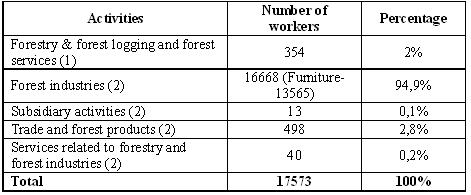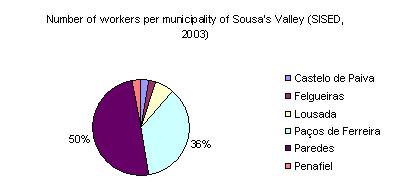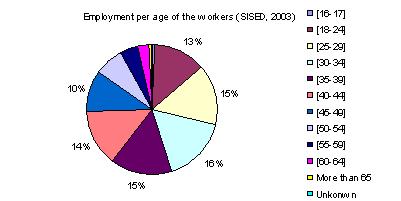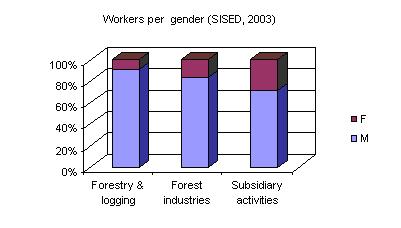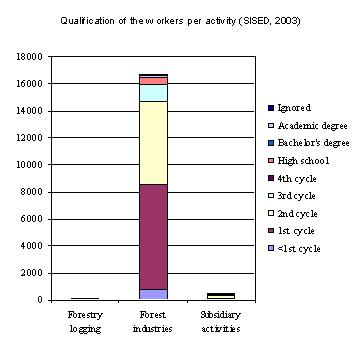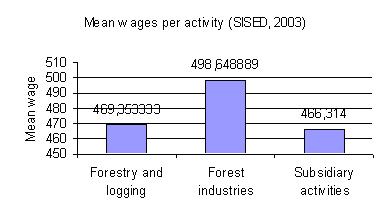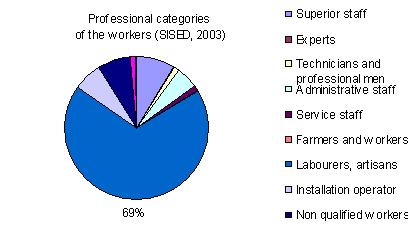Percentage of the total forest area in Sousa Valley: 100 %
Costs
TOTAL COST: 784 €
The total cost includes:
1-Data collection
244 €
2-Data analysis
540 €
* Data from DGEEP: includes 21% of taxes=33,88 €
Data from INE: 86,96 € (discount of 50% for education institutions)
Results
Number of workers per type of activity
Sources: 1) local sources; 2) SISED database
Remarks
According to the expert group report, one used the concept of forest cluster, instead of the concept of forest sector. This is a broader concept is because it includes the following components:
1-Direct employment: activities directly related with the forest sector;
2-Indirect employment: industries and services related to inputs or outputs of the forest sector.
The detailed list of these activities making up the forest cluster is presented in report methodology based on the Portuguese Classification of the Economic Activities (Classificação Portuguesa das Actividades Económicas – CAE – Rev. 2, 1992) and on EUROSTAT NACE Classification Rev. 1.1.
Employment per type of forest activity
In 2003, there were 17573 workers in the forest cluster of the 6 municipalities of Sousa Valley. The activities related to forest industries were the ones employing more workers, 16 668 workers, about 13565 employed by the furniture industries.
Geographic repartition of the employment
At the local level, data shows that in 2003 the two municipalities which had mainly contributed to the employment in the forest cluster in Sousa Valley were Paredes (50%) and Paços de Ferreira (36%). The last one is called by “capital do móvel” (The capital of furniture) because of the amount of furniture produced there.
Age, gender, qualification of the workers and wages
In 2003, 83% of the workers of the forest cluster were between the 18 and the 49 years old being mostly men.
In terms of qualification, in 2003 most of the workers had between the 1st and the 2nd cycle of school education.
Professional categories of the workers
In Sousa Valley, in 2003, most of the workers in the forest sector were labourers or artisans (68, 4%).
Shortcomings and improvements
The source of data for employment (SISED database, 2003) in the forest cluster for the 6 municipalities of Sousa Valley gave detailed information about the number of workers per municipality, gender, age, mean wage, qualification and professional categories of the workers. However, official data was very incomplete for forestry and logging activities and for services related to forestry and forest industries.
1)Data on the number of workers in the Forestry & Logging is probably underestimated.
From the field work done in order to collect data regarding occupational safety and health in forest logging (Indicator 6.06) timber merchants inquired gave a number between 50 and 80 timber merchants acting in the 6 municipalities of Sousa Valley. If each timber merchant employs in average 4 workers (number given by the timber merchants inquired), this gives a number between 200 and 320 workers in this activity (in 2006). This range is higher than the number given by SISED database: 138 workers for Forestry & Forest logging which includes the activities of beekeeping, forestry and forest logging.
2)Data on the number of forest workers in Other animal production – raising of game (CAE 1252), Services related to hunting and game propagation (CAE 1502) and Services related to forestry and forest logging (CAE 2020) were not available at SISED database.
From the field work done in order to collect data regarding the indicators Occupational Safety and Health in forest logging (Indicator 6.06) and Total Economic Value of Forest Production in Sousa Valley (Indicator 6.12) it was possible to obtain local data on employment in those activities which are not mentioned by SISED database.
In the activity Services related to forestry and forest logging (CAE 2020) there are:
-Foresters working for the local FOA in 2003
-Administrative staff working for the local FOA in 2003
-Foresters working for the Technical Forest Offices in 2003 (GTF in Portuguese initials)
-Foresters working for the forest sectors of the agricultural cooperatives in 2003
-Forest sappers working for the local FOA in 2003
-General Direction of Forest Resources (DGRF - regional office):
In the activity Other animal production – raising of game (CAE 1252) there are:
-Workers for raising and selling units for game propagation
In the activity Services related to hunting and hunting propagation (CAE 1502) there is:
-Game guards working in hunting associations
-Other employees of hunting associations
Considering data obtained for all these activities the total number of workers in the forest cluster in Sousa Valley (6 municipalities) is about 17573 workers.
In order to improve this indicator, it have been established contacts with the National Institute of Statistics and the Ministry of Labour in order to carry out a protocol to improve employment data on:
a) Forestry & forest logging and on services related to forestry and to forest industries;
b) Very small enterprises in the furniture industry and related activities.
Comments and conclusion
To assess this indicator there are official data not published but available from the National Institute of Statistics and from the Ministry of Labour (SISED database from DGEEP). However, this official data is incomplete for forestry and logging activities and for services related to forestry and forest industries. This missing data can be obtained but with the help of local informants.
In terms of relevance of the indicator for SFM, since most of the forest employment in this area is related to forest industries and since most of these industries do not consume local forest products, these data, as whole, is not of very high relevance for SFM. What is of more relevance are data concerning the services related to forestry and logging.
Volume and employment quantification is one of the indicators of Criterion 6 considered by NP 4406 2003. NP 4406 2003 states that forest activity has been pointed as a solution of employment with high potential in rural areas. Then, it is important to clarify the contribution of the rural areas to the rural employment, as well as to promote the quality of life of the forest workers (promoting qualification, specific training and equality of genders in forest work).



Initiative Communaitaire FEDER
INTERREG IIIB Espace Atlantique
